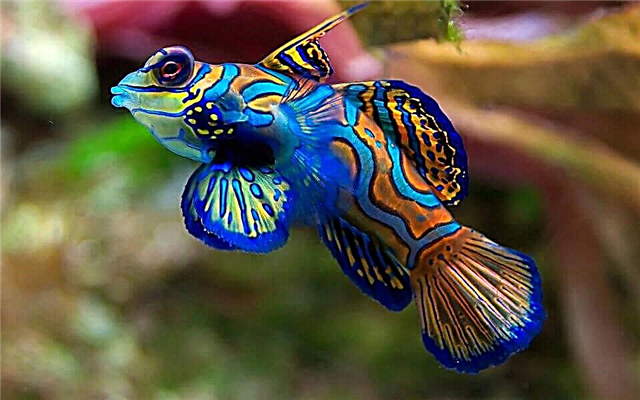It is unlikely that any other device will be able to take away from the Kepler Space Observatory the laurels of the “planet discoverer”. Since launching more than 10 years ago, a giant space telescope has discovered more than 4 thousand planets.
And although the creators of Kepler did not intend their brainchild to search for life in space directly, however, the observatory managed to find about fifty planets on which life could potentially originate. And we will talk about the most likely candidates according to NASA and the University of Puerto Rico.
10. Wolf 1061 c
 Opens a list of 10 planets potentially suitable for life, the "super-earth." So scientists call planets that are very similar to Earth, only more. The radius of Wolf 1061 c is one and a half times greater than the earth's, and the mass is 4.3 from the earth.
Opens a list of 10 planets potentially suitable for life, the "super-earth." So scientists call planets that are very similar to Earth, only more. The radius of Wolf 1061 c is one and a half times greater than the earth's, and the mass is 4.3 from the earth.
This planet is located at a distance of only 14 light-years from Earth, and its density, diameter and temperature are the very thing for the emergence of life. METI International is so confident that life exists on the “super-earth” that every February, when this star system is visible through a telescope, carefully studies the firmament in search of signs given by aliens.
9. GJ 273 b
 The star system, in which another potentially populated planet is located, was discovered about 80 years ago. However, the existence of the GJ 273 b became known much later - in 2013.
The star system, in which another potentially populated planet is located, was discovered about 80 years ago. However, the existence of the GJ 273 b became known much later - in 2013.
This is a big planet; its size exceeds the earth by 2.5 times. It is located exactly in the habitable zone and is presumably composed of hard rocks. And the red dwarf around which it revolves has a quiet disposition and is not prone to violent flashes of radiation destroying all living things.
True, in the current state of science, it is impossible to know exactly whether there is life on the GJ 273 b. But the uncertainty did not stop enthusiasts from launching a message addressed to this star system into space. Packaged in radio waves, it includes mathematical formulas and excerpts from musical works.
8. Kepler-442 b
 This planet is located in the constellation Lyra, 1,200 light-years distant from Earth. Scientists are 97% sure that Kepler-442 b is in the “habitable zone”. It revolves around a red dwarf - a small and dim star.
This planet is located in the constellation Lyra, 1,200 light-years distant from Earth. Scientists are 97% sure that Kepler-442 b is in the “habitable zone”. It revolves around a red dwarf - a small and dim star.
The year on Kepler-442 b lasts 112 days, and the angle of inclination of the axis is too small for the planet to have seasons like earthly shifts. The planet belongs to the category of "super-earth" - its mass is approximately one third more than the Earth.
There is a high probability that the surface of the planet is solid and composed of rock; liquid water may even exist on it.
7. Proxima Cen b
 Surprisingly, life can exist on the surface of one of the planets closest to us. The distance to the beta of Proxima Centauri, which revolves around a small red dwarf, is 4.2 light years. However, despite such a small distance, little is known about it. It weighs a little more than the Earth, and makes a complete revolution around its star in just 11 days.
Surprisingly, life can exist on the surface of one of the planets closest to us. The distance to the beta of Proxima Centauri, which revolves around a small red dwarf, is 4.2 light years. However, despite such a small distance, little is known about it. It weighs a little more than the Earth, and makes a complete revolution around its star in just 11 days.
Such proximity to the star has its drawbacks - most likely, the planet is forever facing Proxima Centauri with only one side. So life, if it is there, exists on a narrow strip between eternal day and eternal night. Also, optimism is not added by violent radiation flashes, which from time to time, an aging, but still active star, sometimes bombard the surface of the planet.
6. GJ 667 C f
 In sixth place in the selection of planets that are theoretically suitable for life, is the sixth planet of the smallest star in the system of the three suns of Gliese. It is perhaps one of the largest planets in the rating - from its mass you can "blind" three Earths!
In sixth place in the selection of planets that are theoretically suitable for life, is the sixth planet of the smallest star in the system of the three suns of Gliese. It is perhaps one of the largest planets in the rating - from its mass you can "blind" three Earths!
Although the GJ 667 C f receives 60% less starlight than Earth, it compensates for this by an increased influx of infrared rays. How favorable this is for the development of life is an open question.
5. Trappist-1 e
 The lonely red dwarf in the constellation Aquarius was surprisingly generous to the planets. To date, scientists have discovered as many as 7 planets, which are strikingly similar in size to our Earth. And three of them are even potentially located in the "residential" zone!
The lonely red dwarf in the constellation Aquarius was surprisingly generous to the planets. To date, scientists have discovered as many as 7 planets, which are strikingly similar in size to our Earth. And three of them are even potentially located in the "residential" zone!
By the way, it was not the Kepler telescope that discovered these planets, but his older brother, the Spitzer infrared telescope.
Scientists believe that on the planet E Trappista-1 there are very good chances for the emergence of not just water, but even the whole ocean. In general, this planet is strikingly similar to the Earth: mass, radius, density, gravity and surface temperature. And it is located not so far away - about 40 light years from Earth.
However, according to recent studies, the chances for the birth of life on Trappist-1 version E are too exaggerated. It is located in a dangerous zone - there is too much carbon monoxide in the atmosphere for the existence of earthly life.
And other scientists, on the contrary, believe that the presence of traces of carbon monoxide in the atmosphere is an indicator of the presence of this very life. You don’t understand who to believe.
4. Trappist-1 d
 This is a small planet, the mass of which barely reaches two-thirds of the earth. It is the smallest in the planetary system of Trappist-1, however, despite the magnitude, approximately 5% of its mass is unstable. So, it can be the atmosphere, oceans and even ice caps. True, according to recent studies, the atmosphere of version D may more likely resemble a Venusian one - dense and very hot.
This is a small planet, the mass of which barely reaches two-thirds of the earth. It is the smallest in the planetary system of Trappist-1, however, despite the magnitude, approximately 5% of its mass is unstable. So, it can be the atmosphere, oceans and even ice caps. True, according to recent studies, the atmosphere of version D may more likely resemble a Venusian one - dense and very hot.
3. GJ 3323 b
Located GJ 3323 b in the constellation Eridanus, at a distance of 17.5 light years from Earth. It was opened only two years ago, and very little is known about it, except that it is located in the habitable zone and is "super-earth". Its mass is two times larger than our planet.
2. K2-72 e
 This Earth-like planet with a rocky surface is located in the constellation Goldilocks. Like many other planets represented on this list, it revolves around a nameless aging red star. And no wonder, since most of the stars in our universe are red dwarfs; they are the most durable of all.
This Earth-like planet with a rocky surface is located in the constellation Goldilocks. Like many other planets represented on this list, it revolves around a nameless aging red star. And no wonder, since most of the stars in our universe are red dwarfs; they are the most durable of all.
Star K2-72 e will shine for many years after our sun goes out. Although the planet is located in the habitable zone, most likely, it is forever facing its star with only one side (like our Moon to the Earth). Therefore, life on it, if it exists, developed on a small island between light and dark.
1. Teegarden b
 Probably the most livable planet Teegarden b was discovered recently - at the beginning of 2019. Around the star of Tigarden in the constellation Aries, two planets revolve at once, the conditions on which resemble terrestrial ones. And it is located just 12 light years from the Sun.
Probably the most livable planet Teegarden b was discovered recently - at the beginning of 2019. Around the star of Tigarden in the constellation Aries, two planets revolve at once, the conditions on which resemble terrestrial ones. And it is located just 12 light years from the Sun.
Like other terrestrial planets on which life can potentially exist, it is located in the “inhabited zone” - not too far, not too close to its star. And it seems that of all 10 planets in our ranking, it is Teegarden b that is most similar to our Earth, both in mass and density, and even possible surface temperature.
The fear is inspired only by violent and violent radiation flashes that from time to time emit red dwarfs. Powerful streams of radioactive particles can destroy any life in its path.
How scientists determine whether life on the planet may or not
Our knowledge of the Universe is limited by the experience accumulated by mankind in the process of evolution. So scientists, determining whether life is possible on this or that planet, are primarily guided by the well-known planet Earth. In their opinion, life can be born on the planet if it meets the following criteria.
- Comfort zone.
The planet should not be very close or very far from its star. And, roughly speaking, it should not be very hot and not too cold. - Fulcrum.
The planet must have a solid surface. Giant gas soup like Jupiter or Uranus is thought to be a poor habitat for living things. - Size matters.
The planet must be large enough to form a red-hot core. It is the core that creates the magnetic field around the planet, protecting its surface from destructive solar radiation. - Dense atmosphere.
Its thickness should be just such as to protect fragile living organisms both from radiation and from foreign objects, as well as give them something to breathe. - Tiny residents.
It is worth adding that the possible life is likely to be microbial. Judging by the fact that the first microorganisms appeared on our planet about 4.25 billion years ago (and the planet itself arose about 4.54 billion years ago), the chances of populating the Universe with “living dust” are quite high. But whether it is capable of turning into something more is a completely different question.











